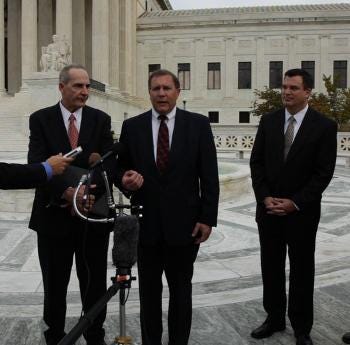
Bilski v. Kappos was one of the most anticipated decisions on patent law by SCOTUS (Supreme Court of the United States). Law geeks (like me ?) used to run weekly checks on the status of the case. The stakes involved in Bilski were huge and it promised to be the Sony v. Universal Studios (where the substantial non-infringing uses defense in copyright law was expounded) of patent law. This may sound like hyperbole, but superlatives (sometimes even expletives) were hard to avoid when the subject was Bilski. Since the case concerned the (in) validity of a business method patent it was legitimately politicized by the open source movement as a case where a categorical holding could be made on the legality of software patents.
Background
Most people seemed to have reached a point of dissatisfaction with software patents when the Bilski appeals process began. This was due to software patents being increasingly claimed by “patent trolls” who would lurk and then spring litigation on technology companies. These lurkers were companies whose sole purpose was not to innovate but to maintain a portfolio of patents to claim money out of legitimate businesses later. This was having an impact on venture capital funding for startups, open source products and even successful companies who were sued for products such as blackberry mobile phones. The threat of such patent litigation was a real concern and most people agreed that grants of such broad, “business method” and “software patents” was contrary to the scope and intent of the federal patents act, allowed after the State Street Bank holding. Hence, the decision by the Federal Circuit in Bilski that, a patent application for, “a claimed invention that explains how commodities buyers and sellers in the energy market can protect, or hedge, against the risk of price changes.” was invalid, was widely applauded and appreciated. The holding went further and closed the door on the State Street Bank carve out which held that an invention should be patent eligible if it involves some practical application and “it produces a useful, concrete and tangible result.” This in the interim, meant the end of business process and software patents. Hence, the appeal to SCOTUS was seen as the litmus test for software patents.
a fractured holding
Though the SCOTUS affirmed the holding of the Federal Circuit that the Bilski application was invalid it did so while substantially altering the reasoning. The court while invalidating the patent application of Bilski held that, (a) it did not prohibit business process patents in principle when it stated that, “The Federal Patent Act does not categorically exclude business methods from eligibility to be patented.”; (b) sought to avoid a broad comment on software patents; © called the MoT test not the singularly determinative test for determining patentability (“‘machine or transformation’ test may be a useful and important investigative tool, but it is not the sole test for determining whether a ‘process invention’ is patentable”); (d) did not elaborate or formulate an singular or plural, determinative test or criteria for the eligibility of business method and software patents.
The first thing which is striking of the SCOTUS Bilski decision, is how fractured it is. Several law-blogs have commented and I agree that this fractured decision is the reason for the delay in rendering of the decision and was the product of bargaining as to the final text of court opinion. The decision has been rendered by Justice Kennedy with the 4 of the court’s conservatives backing it (Justices Stevens, Alito, Thomas, and Scalia, the latter parting company on one aspect of the decision) and there is significant separate opinion by Justice Stevents having the liberal flavor and disagreeing with the reasoning permitting business method patents. Another thing which is striking is the reluctance by the court to formulate a bright line rule. It talks a lot about uncertainty and patents but it does not say much to end the uncertainty.
In the end the Bilski case was decided on facts, and it does not seem to prescribe an obvious broad formulation of patent law. The deeply fractured verdict is less prescriptive and more relative. In fact the only thing it says clearly is, “eeerm.. maybe?”.
Read the decision here
Related articles
- Bilski and Patent Reform (avc.com)